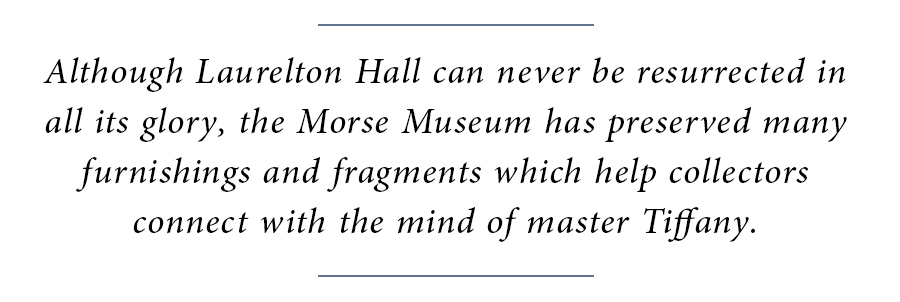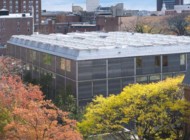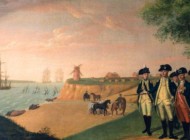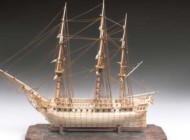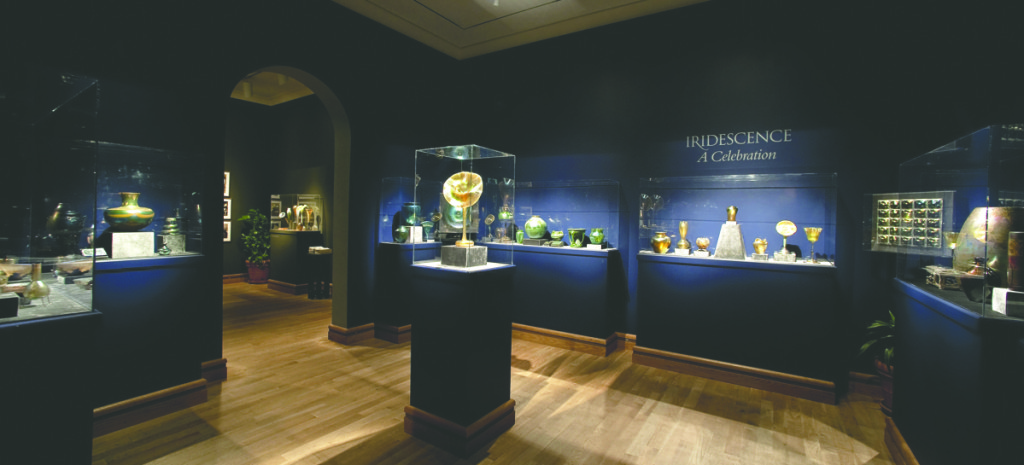
An installation shot of “Iridescence – A Celebration,” on display through September 26, 2021, at the Charles Hosmer Morse Museum of American Art.
By Karla Klein Albertson
WINTER PARK, FLA. – For connoisseurs in the Northeast who think they have seen all of Tiffany’s treasures, it may be time to book a train to Florida. Skip those theme parks in nearby Orlando and make a beeline for the Charles Hosmer Morse Museum in Winter Park, where “Iridescence – A Celebration” is on display through September 26, 2021. The exhibits – around 50 drawn exclusively from the permanent collection – include blown glass vessels, pottery forms, lighting and tiles. Many are marked Tiffany, but there are also comparative examples from the same time period produced by other firms in the United States and abroad. Workshops everywhere were simultaneously striving to produce that elusive shimmering effect.
If Louis Comfort Tiffany (1848-1933) ever sang about a few of his favorite things, iridescence was at the top the list. He was inspired in part by the effect as it occurs in nature – on hummingbird breasts and butterfly wings, for example. But he also had observed objects of ancient Roman and Middle Eastern glass which had become iridescent through chemical changes wrought by time and burial in the earth. Several examples of these archaeological artifacts are included in the exhibition, and Tiffany had his own collection of pieces in his home.
As mentioned, all the displays come out of the Morse’s own extensive collection, so a few words about the source of the museum’s holdings. Museumgoers may have heard the institution’s name when the Metropolitan Museum of Art presented the landmark exhibition “Louis Comfort Tiffany and Laurelton Hall” in 2006, a show which was organized in collaboration with the Morse Museum.
The loss of Laurelton Hall, Tiffany’s summer residence and architectural masterpiece at Oyster Bay on Long Island, is a heart-rending tale, made more painful by the existence of vintage photos – exterior and interior – of the spectacular unified designs he had created. Iridescence in the form of tiles and glass elements played an essential role in the impression produced. The sad history in brief, the trustees of the Tiffany Foundation sold off the contents of the house in 1946, then the property and its land in 1949. Finally, the structure itself was destroyed by a devastating fire in 1957.
In her introduction to the MMA’s 2006 exhibition catalog, curator Alice Cooney Frelinghuysen outlined what happened next: “However, the artist Hugh F. McKean, who had studied at Laurelton Hall, and his wife Jeannette Genius McKean, salvaged many of the original Tiffany windows and architectural decorations. They subsequently donated these to the Charles Hosmer Morse Museum of American Art, in Winter Park, Fla. (which Jeannette McKean had founded). Today, the Morse Museum holds the largest collection of surviving materials from Laurelton Hall. The McKeans also made a notable gift to the Metropolitan Museum of Art, the four-column loggia from Laurelton, which stands in the museum’s Charles Engelhard Court in the American Wing.” And that statement covers the story behind one of the most memorable installations at the Met and hints at what can be seen on a visit to Winter Park.
Fortunately, that fascinating catalog is still available through online sources, and one of the contributors, Jennifer Perry Thalheimer, is now the Morse curator and collection manager who has organized the “Iridescence” exhibition: “I think, if you come to the Morse expecting to see what you know about Tiffany, you will find that there is so much more than you ever realized. You’ll also find a lot more information about this time period in art history. People associate Orlando with the amusement parks and all that good stuff, but they’re surprised when they realize there’s a world-class museum here. When they visit, they don’t realize how much we’ve grown over the years. Now, it’s a museum that takes hours to visit. So much more material has come into the collection; we get donations of really wonderful things. It’s an experience you can’t forget, everyone who comes is overwhelmed.”
In a recent interview with Antiques and The Arts Weekly, she continues, “We’re very happy to have the Tiffany collection, but really we are a museum devoted to a specific period in art history. Our time span is between the 1850s to about 1930, and there are wonderful international art movements within that time period. Because we’re able to use iridescence as an excuse, this exhibition gave us the opportunity to find all these objects in our collection that use iridescence in their decoration – pottery or enamel or glass, in tile form or as a vessel. We were able to get all these different materials together in one place to exhibit and simultaneously display objects that are from the Arts and Crafts or Art Nouveau movements. It puts them all together with this one uniform aesthetic, which was iridescence.”
Not far from exhibits of Tiffany’s own glass, visitors to this show will see a flaring vase, circa 1905, by the Quezal Art Glass & Decorating Company in Queens, N.Y., and a rounded Aurene vase, circa 1904, from the Steuben Glass Works in Corning, N.Y. There are pottery forms with iridescent glazes from the Weller Pottery in Zanesville, Ohio, the Pewabic Pottery of Detroit, Mich., and the Rookwood Pottery in Cincinnati, Ohio. Among the European entries, there are turn-of-the-century vases from the Loetz glass factory in Bohemia and a circa 1930 enameled copper bowl by Camille Fauré in Limoges, France.
When asked to name a favorite showstopper, the curator replies, “The piece that is at the center of the exhibition is the pansy vase (Favrile 1911) that people are drawn to because you go face to face with this super-sized pansy.” The glowing vase in Tiffany’s sought-after Favrile glass is statuesque at 18½ inches. She goes on, “Also, we still acquire pieces, and this past winter, we purchased a really special vase of iridescent glass that Tiffany kept for his own collection – that’s marked on the bottom of it. It’s probably a one-of-a kind piece, so we were really happy to exhibit it among other pieces with the same iridescence.”
“For some reason, glass in windows is something you really have to experience in person. One of the great things about this exhibition is that as you walk, everything changes as the light subtly shifts and so then there’s a new color that you see. Everything seems to move with you because the light is changing as you switch your position.”
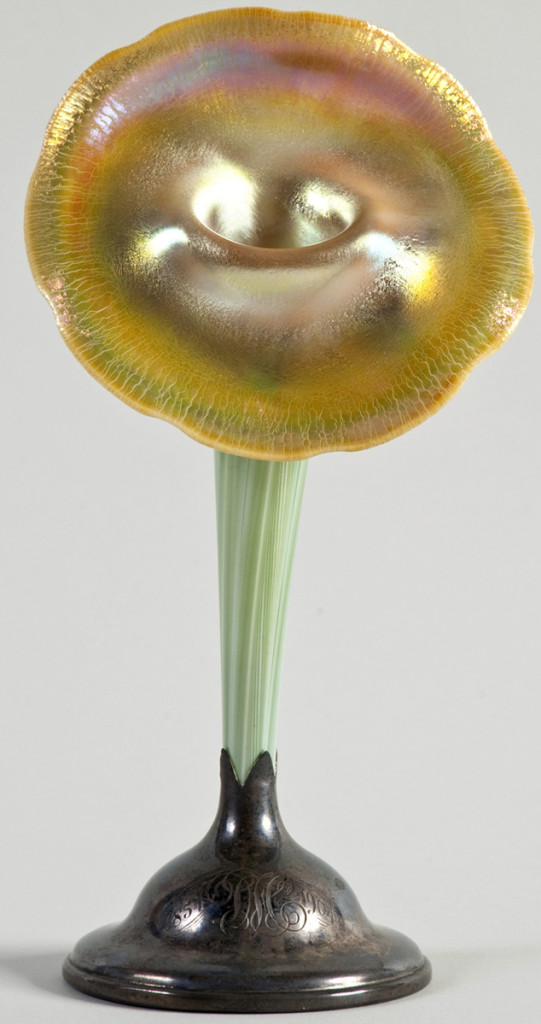
Vase, Quezal Art Glass & Decorating Company, Maspeth, Queens, N.Y., circa 1905; base: Herbst & Wassall, Newark, N.J., circa 1903-31. Blown glass, silver.
Thalheimer obviously feels a special attachment to her work: “I grew up on Long Island, near what used to be property for Laurelton Hall. As a kid, I would venture in and parts of it were still visible, the lower section where Tiffany had his foundation and some of the grounds were still intact. That’s really what brought me to the Morse Museum. So, for me, when I talk about Laurelton Hall, and I see pieces that were originally there, it really is very close to me.”
Although Laurelton Hall can never be resurrected in all its glory, the Morse Museum has preserved many furnishings and fragments which help collectors connect with the mind of master Tiffany. Not to be missed is the permanent installation of the Chapel, inspired by Byzantine prototypes, that he personally designed for the 1893 World’s Columbian Exposition in Chicago, where it proved a popular attraction. After the fair, the entire chapel was purchased and given to the new Cathedral Church of St John the Divine in New York City, but it was unfortunately neglected down in the crypt. Tiffany reacquired the parts and installed them in a separate building on the grounds of Laurelton Hall. Not affected by the 1957 fire, the chapel elements – windows, columns, furnishings, a splendid baptismal font – were acquired by the McKeans and in 1996 the Morse Museum decided to install the reconstructed chapel in its own wing.
In addition to the aforementioned MMA catalog, a good reference to have on the shelf is The “Lost” Treasures of Louis Comfort Tiffany by Hugh F. McKean (1908-1995), who was the Morse’s director from 1942 until his death. The pages are filled with color plates of Tiffany windows and decorative arts, as well as fascinating vintage images of the interiors in the designer’s commercial and residential properties. There is even an entire chapter on some ambitious Tiffany costume fetes with old photos of bedecked family and friends.
The Charles Hosmer Morse Museum of American Art is at 445 North Park Avenue. Learn more about the collection at www.morsemuseum.org or 407-645-5311.

